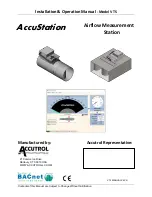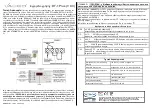
CLS200 Series User’s Guide
Chapter 8: Troubleshooting and Reconfiguring
144
If the controller displays
BATTERY DEAD
:
1. Acknowledge the alarm.
2. If the error message remains, make a record of the settings, turn the power to the controller
off, then on again.
3. If the error message returns when power is restored, perform a NO-key reset. See
.
4. If the error is not cleared, contact your supplier for further troubleshooting guidelines. See
Removing or Replacing the Battery on page 152
Ambient Warning
The ambient warning alarm indicates that the ambient temperature of the controller is too hot or too
cold. Ambient warning occurs when the controller’s temperature is in the range of 23 to 32°F or 122
to 131°F (-5 to 0°C or 50 to 55°C). The operating limits are 32 to 122°F (0 to 50°C).
If the controller displays AW in the lower left corner of the display:
1. Acknowledge the alarm.
2. If the error message remains, check the ambient air temperature near the controller. Adjust
ventilation, cooling or heating to ensure that the temperature around the controller is 32 to
122°F (0 to 50°C). If the unit is functioning correctly, the error will clear when the ambient
temperature is within range and the alarm has been acknowledged.
3. If the ambient temperature is within range and the error persists:
a. Turn the power to the controller off.
b. Remove the boards from the CLS200 housing. See
Replacing the EPROM on page 150
.
c. Reseat the boards and turn the power on.
4. If the error persists, make a record of the settings then perform a NO-key reset. See
.
5. If the error is not cleared, contact your supplier for further troubleshooting guidelines. See
Return Material Authorization (RMA) on page 3
.
H/W Ambient Failure
The hardware ambient failure alarm indicates that the ambient sensor in the CLS200 is reporting that
the temperature around the controller is outside of the acceptable range of 0 to 50°C. This error can
also occur when there is a hardware failure.
If the controller displays
H/W AMBIENT FAILURE
:
1. Acknowledge the alarm.
2. If the error message remains, check the ambient air temperature near the controller. Adjust
ventilation, cooling or heating to ensure that the temperature around the controller is 0 to
50°C. If the unit is functioning correctly, the error will clear automatically when the ambient
temperature is within range and the alarm has been acknowledged.
3. Remove any connections to the 5VDC reference (TB1-18) on the back of the controller. If
this corrects the problem, there was an error in the wiring. You may need to consult technical
















































